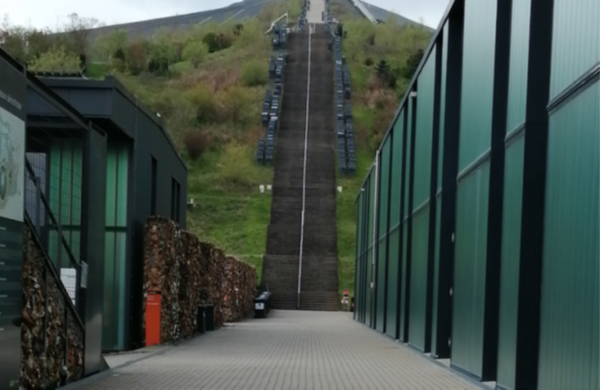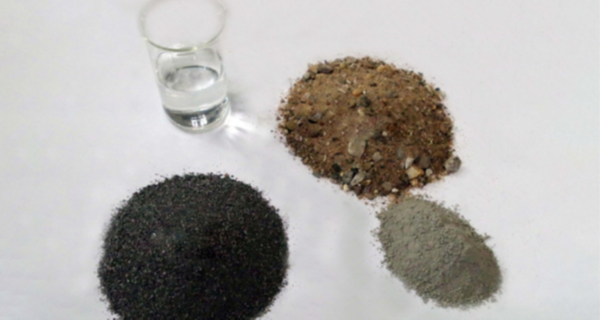ASHCON
ASHCON - Use of processed incinerator bottom ash as a raw material in concrete production
Resource-efficient circular economy - construction and mineral material cycles (ReMin)
The ASHCON project deals with the utilization of incineration residues from waste incineration plants for mixed municipal waste - i.e. what remains of normal household waste after incineration. While heavy metals can already be extracted from the incineration residues for reuse, there are still no high-quality recycling strategies for the remaining residues. The project closes this gap and aims to make the residues usable for concrete production.
The project is being funded as part of the "Resource-efficient circular economy - construction and mineral material cycles (ReMin)" funding measure. "ReMin" is part of the BMBF research concept "Resource-efficient circular economy" and is aimed at resource-efficient construction and the expanded use of mineral secondary raw materials from construction waste, slag, ash and mining residues.
Incinerator bottom ash as a substitute for natural aggregates
The increasing scarcity of raw materials in the construction materials sector combined with the finite capacity of landfill sites has led researchers from various disciplines to join forces in the ASHCON project to develop recycling routes for incinerator bottom ash (IBA). The composition of this waste incineration ash, also known as bottom ash and slag, is very complex. It consists mainly of molten mineral components, stones, concrete, glass or ceramic shards, but also up to ten percent of metallic components. While heavy metals can already be extracted for reuse, there are still no high-quality recycling strategies for the remaining MV residues. Due to their properties, the low-metal components can be used as a substitute for primary raw materials in the production of concrete. The prerequisite for this is that sufficient quantities of MV residues of a certain quality or uniformity are made available. In order to generate the highest possible quality of MV residues for further utilization, a new industrial measuring and sorting process is included in the project and investigated with regard to its applicability to MV residues and its performance.
On the site of the Leppe landfill of the Bergischer Abfallwirtschaftsverband (BAV), deposited ashes and freshly delivered MSW are sampled with the support of AVEA GmbH and examined in the building materials laboratory of the :metabolon Institute of the Technical University of Cologne with regard to their particle size distribution. The classes of grain sizes 2-8 mm relevant for processing are obtained.

Processing by means of electrodynamic fragmentation
At the Fraunhofer Institute for Building Physics (IBP), a new extraction technique is used to extract the metallic components of MSWI. Fragmentation of the waste incineration slag is carried out electrodynamically at the phase boundaries of the melt products. As the mineral components of the slags have a low electrical conductivity, they can be selectively split. The resulting fragments are classified again in order to obtain the minimum sortable grain size of 2 mm.
Analysis concept from laboratory to production
The processing technology is evaluated by the chemical-mineralogical characterization of the residual components at IBP. In parallel, a material analysis (multi-element screening) is carried out at the Aachen Institute for Nuclear Training (AINT) in Eschweiler using Prompt Gamma Neutron Activation Analysis (PGNAA). This innovative, non-destructive and integral analysis method is to be used for online monitoring of material flows and qualified as the basis of a sorting process for substitute building materials. The environmentally relevant aspects for concrete applications are being investigated at the Institute for Building Materials Research at RWTH Aachen University (ibac). This will evaluate both the environmental compatibility of the substitute building materials and the durability of the resulting materials.
Industrial recycling routes and economic considerations
The influence on the processing properties when substituting the grain sizes in concretes is investigated in rheological studies in the building materials laboratory and in the laboratory for colloid chemistry at the TH Cologne. These characteristic values form the basis for the use of the substitute building materials by the two industrial partners Fertigbeton Rheinland GmbH & Co. KG and METTEN+Stein und Design GmbH & Co. The final recycling analysis is carried out at Münster University of Applied Sciences. A material flow management and quality assurance concept will be developed, a cost analysis for the processing steps developed will be prepared and compared with conventional landfilling according to economic criteria. Based on this data, the Institute of Technology and Resource Management in the Tropics and Subtropics (ITT) at Cologne University of Applied Sciences will carry out an eco-efficiency analysis of the recycling methods developed.

Funding measure
Resource-efficient circular economy - construction and mineral material cycles (ReMin)
Project title
ASHCON - Use of processed incinerator bottom ash as a raw material in concrete production
Duration
01.02.2021-31.01.2024
Funding reference
033R258
Funding volume of the consortium
1,014,469 euros
Contact
Prof. Dr. Björn Siebert
Cologne University of Applied Sciences | Faculty of Civil and Environmental Engineering (F06)
Betzdorfer Str. 2
50679 Cologne
Phone: 0221 8275 2708 | Email: bjoern.siebert@th-koeln.de
Project participants
Aachen Institute for Nuclear Training GmbH (AiNT); Fertigbeton Rheinland GmbH & Co. KG; Münster University of Applied Sciences, IWARU; Fraunhofer Institute for Building Physics IBP; METTEN STEIN + Design GmbH & Co. KG; RWTH Aachen, Institute for Building Research Aachen (ibac)
Data sheet
Download data sheet